Ready to demolish your electricity bills with solar, but feel like you’re stepping into the Wild West?
I’ve just released the 2024 edition of my plain-English video guide to solar. It has all the info you need to confidently buy solar from a great installer.
If you don’t feel like watching – here’s a summary.
Why get solar?
I hope this is obvious by now, but with electricity bills going up and up, a well-designed solar system (and a good electricity plan) can eliminate bill shock for good.
How many panels should you buy?
My advice is simple – put on as much solar as you can reasonably fit and afford. Aim for at least 10kW (which is about 24 modern panels).
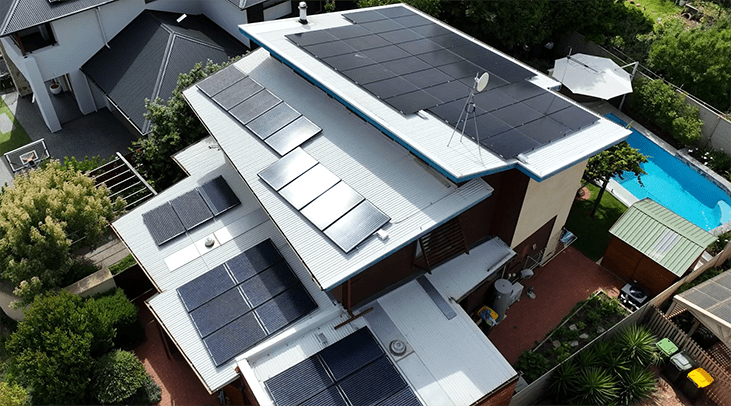
I have almost 20kW of solar on my roof – even the south-facing sections
Even if you ‘don’t need’ a large system, buying an electric car and/or battery will make you glad you have one. I’ve never heard anyone complain they put on too much solar.1
Anatomy Of A Solar System
A solar system is made up of three main components:
- The solar panels, which convert sunlight into energy
- The inverter, which turns the DC from your panels into AC electricity your home uses
- The monitoring, which lets you see how your system is performing
Solar Panels
Here’s the truth about solar panels these days: The Chinese have gotten so good at making high-performing, inexpensive panels that they’re now a commodity. Some wholesalers who sell high-end gear will get mad at me when they read this, but it’s true.
Check out my panel comparison table, and you’ll see the specs are all similar.
Ten years ago, there was a big difference in performance and warranties between a budget-end panel and a premium-end one. Now, most panels come with 25-year warranties, and – as long as you avoid the crappy brands – the difference in performance is marginal.
Brands I recommend
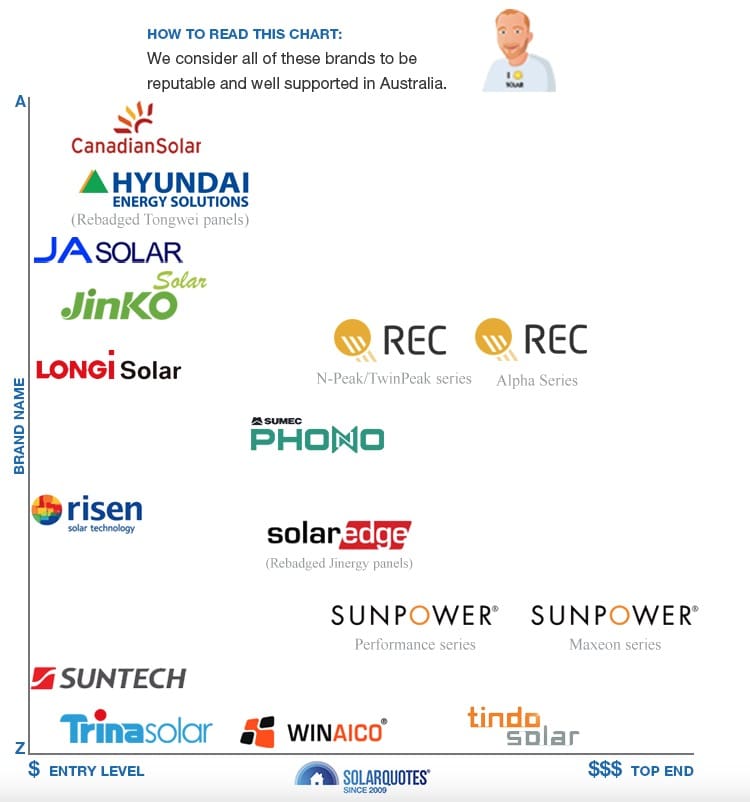
What’s the difference in price for a system using top-end brands over entry-level ones? Approx $400 per kW installed.
Solar inverters
This box of tricks converts the DC electricity from your solar panels into the AC electricity everything in your home uses.
You have three choices here:
- String inverters
- Hybrid inverters
- Micro inverters
String inverters are the cheapest and most straightforward choice. They’re a box mounted to your wall, and all the panels are wired into them:
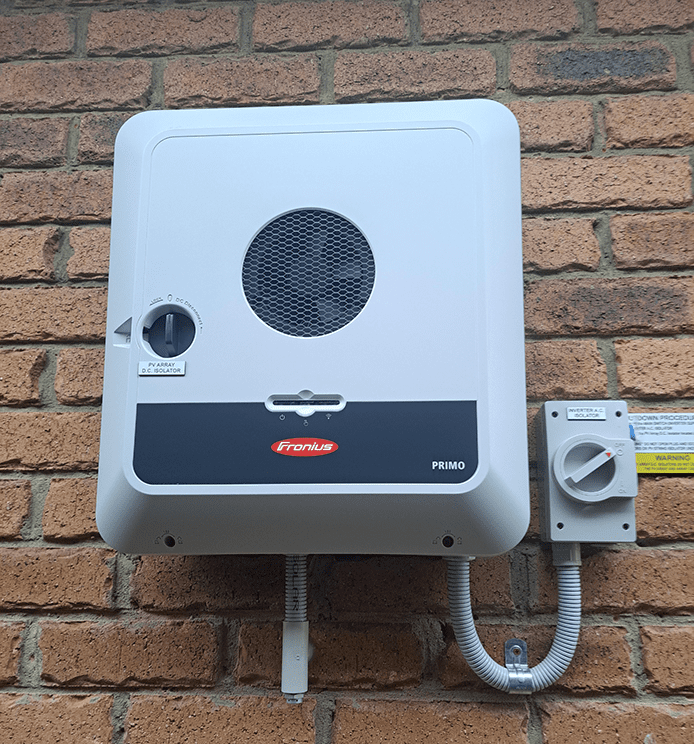
A Fronius Gen24 ‘Primo’ single-phase string inverter
Hybrid inverters are a more expensive type of string inverter. They contain the electronics to handle both solar and batteries.
Their downside is you’re locked into using batteries compatible with your hybrid inverter model. And if you want to buy the inverter first and add batteries later, it’s possible that compatible products could be discontinued. You’re also spending extra dollars for a feature you’re not using yet.
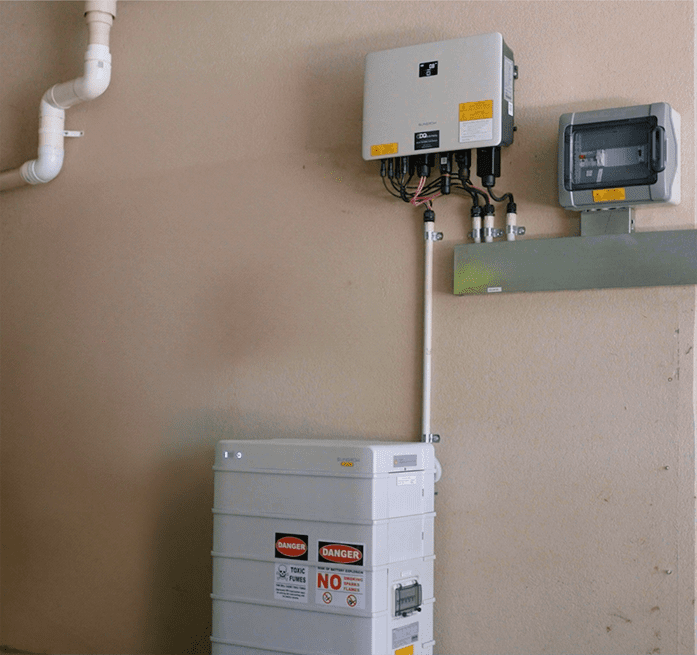
My Sungrow hybrid inverter + Sungrow battery
Finally, microinverters are book-sized inverters bolted on behind each solar panel:
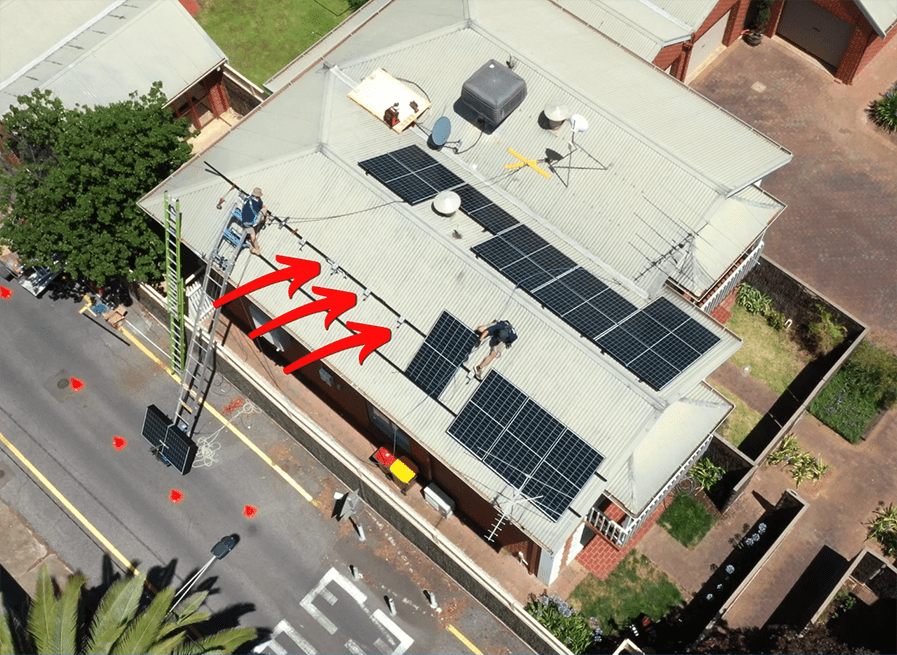
These are actually SolarEdge optimisers – not microinverters, but the installation method is similar.
What are their advantages?
✅ They’re safer thanks to the DC > AC conversion happening at the panel.
✅ They can be your only choice if you have a complicated roof layout
✅ You can monitor the performance of each panel individually. (This gets old after two weeks unless you are a complete nerd.)
The downside?
❌ They’re significantly more expensive than string inverters. Expect to add 20% or more to the cost of a system if you’re using microinverters.
Inverter brands I recommend
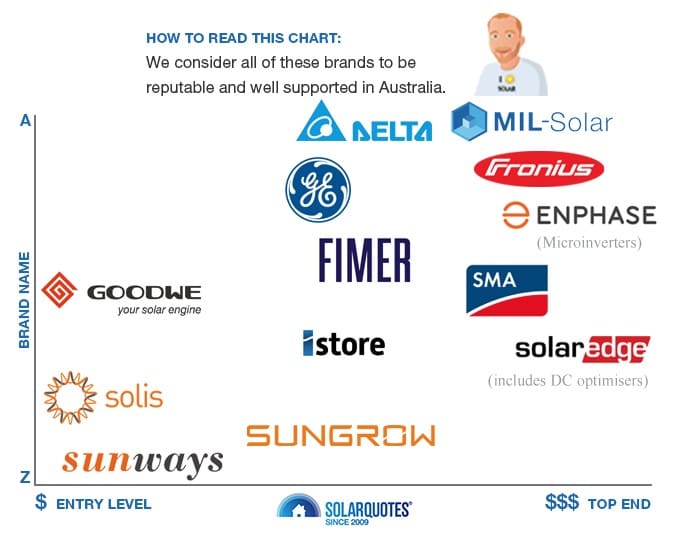
Inverter brands I’d recommend to a friend
Monitoring
To check how your system is performing and see the energy your home uses (and when), you need a smart meter (aka a consumption monitor) that goes inside your switchboard.
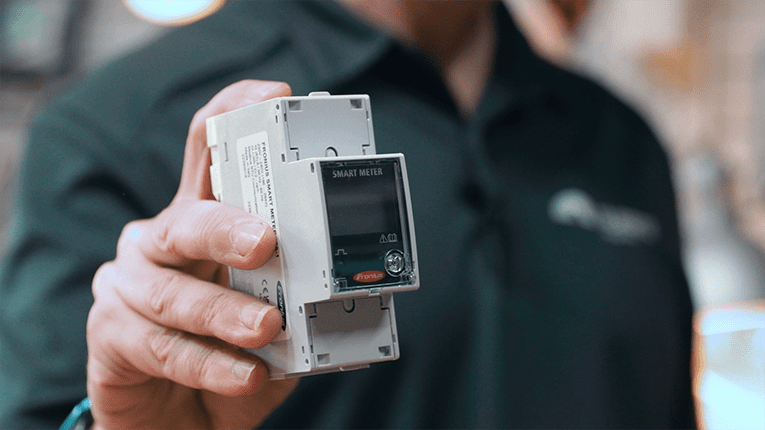
A single-phase Fronius smart meter
This is confusing because your electricity meter is also called a smart meter:
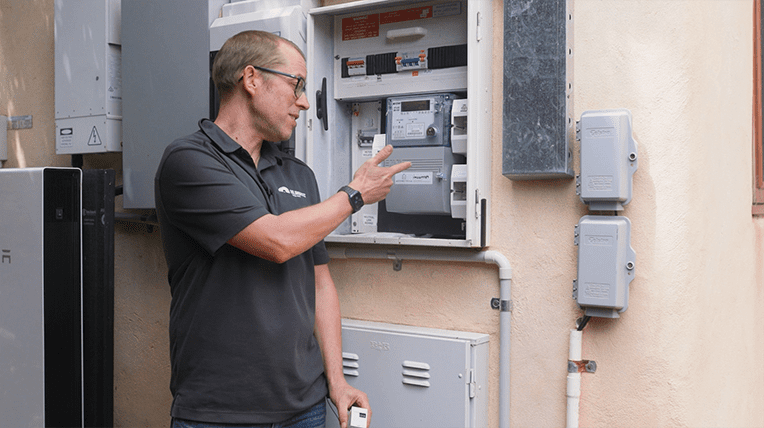
My electricity meter
What’s the difference? Your electricity meter only shares its data with your energy retailer. A consumption monitor shares it with you – in real-time.
Consumption monitors are optional, but in my opinion, they are an essential part of a solar system and should be considered mandatory. If you can’t keep track of your energy use, you can’t change your habits to maximise your savings from solar.
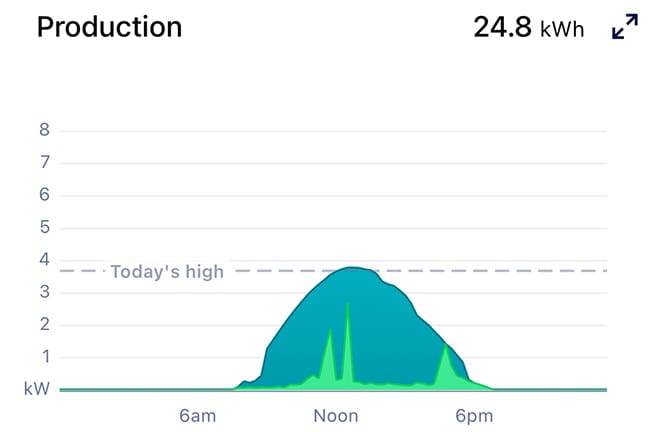
The more you keep your usage inside the ‘solar curve’, the lower your bill.
Do You Need Tilt Frames?
The typical Aussie roof has a tilt of 15 to 22 degrees. While the ‘perfect’ angle to maximise your generation annually is usually closer to 30 degrees, the performance gain is marginal.
So – don’t worry about using expensive tilt frames to get the perfect angle. Mount your panels flush with your roof.
The exception to this is if you have a flat roof because your panels won’t self-clean in the rain. If your roof is flat, get tilt frames – but if you have limited roof space, tilting them north can kneecap your total system size. Consider east-west tilts to fit a larger system on your roof:
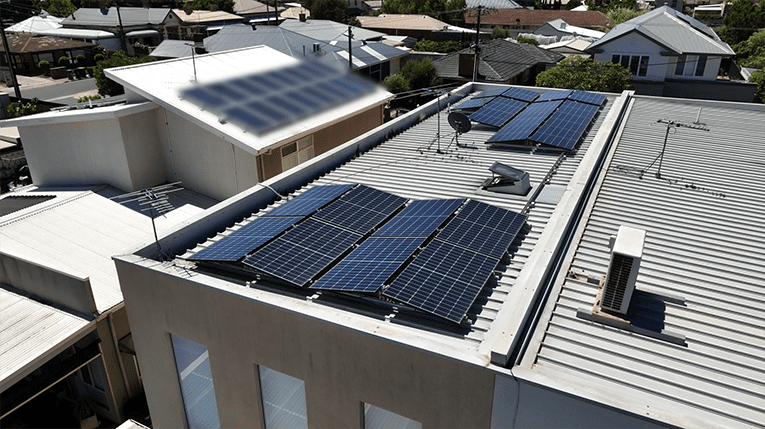
Brilliant east-west tilt design by the installer
What About Shade?
Shade kills solar.
If your roof is heavily shaded, any installer worth their salt will run a shade analysis (in-person with a SunEye or with shade mapping software) and be able to tell you exactly how much generation you’ll lose.
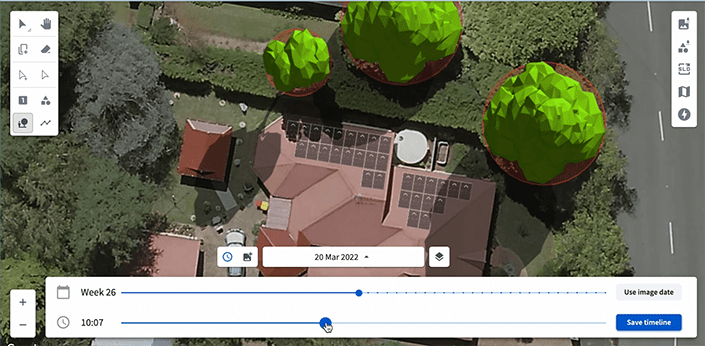
A screenshot from the shade mapping software Pylon
Never buy solar from an installer who has only squinted at your roof and said, ‘She’ll be right’.
And don’t think you need more expensive micro-inverters or optimisers if you have shade. From all the data I’ve seen, premium string inverters (like Fronius) perform as well in shady conditions.
Why Not Get One Of Those Cheap Deals Off The Telly?
A dirt-cheap system may last a decent amount of time. But I wouldn’t bet money on it.
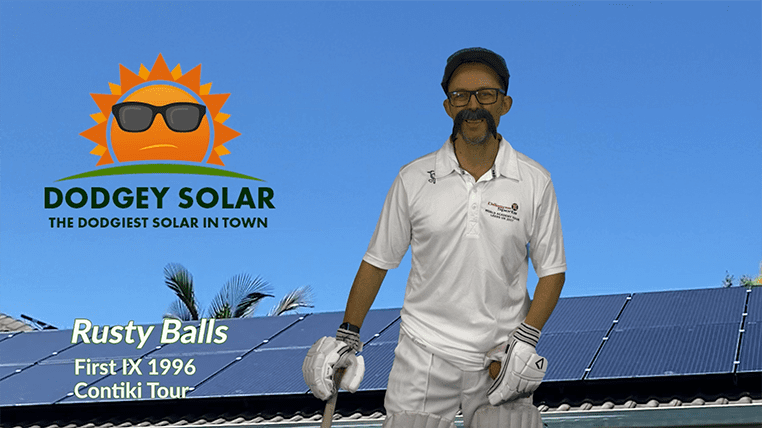
Cricketers selling solar?
Good, sustainable solar companies need to sell systems at a fair price that lets them:
- pay their Australian staff a fair wage (so they take their time with an install and don’t rush from one job to the next)
- buy good equipment backed by a local Australian support team
- and provide good after-sales service.
When you buy cheap, all incentives point towards a rushed install of crap brands and no-one in Australia to pick up the phone if you have a problem.
Well, What About That ‘Great Deal’ The Nice Doorknocker Offered?
Commonly, doorknocking solar companies pad their quotes with fat margins, hoping you won’t get any quotes for comparison and realise you’ve been ripped off. You’d hope by overpaying, you’d at least be getting a well-installed system for all that cash. But it’s all too common to see shoddy work from overcharging companies.

Do not open your door to this man!
Too Cheap! Too Expensive! How Do You Avoid Shonks?
- Don’t go with the cheapest company you can find.
- Avoid door knockers and direct mail.
- Research a company’s online reputation. Don’t just look at one source of reviews (like Google) – check multiple review websites (Trustpilot, Facebook, Product Review, Reviews.io, amongst others)
The SolarQuotes website has an extensive database of solar installer reviews to help you out here.
Haven’t Got The Time To Do All That Research Yourself?
This is why I created SolarQuotes 15 years ago. My website makes it easy to get quotes for comparison from installers I have personally vetted and trust. You can feel confident you’re being charged fair market rates for good quality gear.
If you want to take the plunge and get quotes, fill in my form and I’ll do my absolute best to match you with up to 3 installers I have personally vetted and trust.
Footnotes
- Just be aware this is general advice for the typical Aussie home. Of course, if you have freakishly small energy consumption, then you don’t need a big-assed solar array on your roof. ↩

 RSS - Posts
RSS - Posts



How is GE a better ranked inverter than GoodWe? They are manufactured by GoodWe!! In the words of a well-known politician, ‘Please Explain’? We also highly rank the Delta, FIMER and obviously the Rolls Royce of inverters, the Enphase Microinverters. But GE, Com’on!!! It comes with GoodWe documents, and also starts with the letter G.
Glenn,
Have a look at the x-axis. Cheaper to more expensive. Further to the right means it costs more, nothing else. GE’s are made by Goodwe and you pay more for the badge.
It is a weird layout on the chart. We get customers all the time that read it the same as how Glenn did.
They don’t realise it is not tiered or one side is higher quality, it is just these brands we trust but there is no rank for quality levels in it.
But on a side note, I offer no suggestions on how to make it better.
The idea is that when you get some doorknockers claiming their $15,000 6.6kW Goodwe / Risen system is ‘Top-Of-The-Range’ they can see that, although those brands are fine, they should not be paying premium prices for them.
I have a 6.6kW PV system with Leapton panels and a Growatt string inverter. It does not appear on your charts, but I have been very happy with it for three years now, producing about 10,000kW per year.
Sometimes I wonder if manufacturers pay money for this kind of advertising, and how people decide what brand y they push 😉
Unfortunately, in WA you can’t have more than 6.6 and your feed-in its limited to 5kW, or even less if the public network is overloaded.
Despite the drawbacks, my solar amortised the initial cost already after about 10 months, and it’s saving me about $3000 in electrical bills every year.
Dirk, I can guarantee that we (SolarQuotes) receive no compensation whatsoever from manufacturers to be on these charts. They are solely based on consumer and installer feedback about their systems and how well these companies support their customers when things go wrong.
We’re not necessarily saying that other brands are bad, but the ones on the charts above are ones we’d be happy to have installed on our Grandmothers’ house.
Trevor, I don’t know your nanna 😁 but what’s to be said against my system with Leapton and Growatt? I would certainly recommend them, because they work well and have not given me any trouble whatsoever from a consumer perspective. Even the cloud service, albeit in China, is surprisingly stable. For some reason you are pushing some brands over others
Hi Dirk,
I’m glad you’ve had some luck. I certainly didn’t with the multiple replacement GroWatts I had to swap over with no compensation forthcoming, just second hand warranty units.
https://www.solarquotes.com.au/blog/are-growatt-inverters-any-good-heres-an-installers-opinion/
They’ve also had to run two product safety recalls that I’m aware of.
They are cheap however.
“Sometimes I wonder if manufacturers pay money for this kind of advertising, and how people decide what brand they push”.
Wonder no more: the criteria for being on the chart are here:
https://www.solarquotes.com.au/trusted-solar-brands-criteria/
Hi Finn,
Great that you’ve updated, a wonderful service to the environment and community.
I have a 11kW system installed by one of your recommended installers.
Would it be possible to make a calculator that will tell me when adding a battery makes $ense?
Meh back-of-the-envelope sums say no at the moment.
Cheers David
Hi David,
Try this link and see how you get on.
Cheers
A very good video explanation,…. as you say “fill your roof” to North East and West,…. but we should note that south facing low angle panels give over 70% of the maximum northward facing yield as well, When cloudy, or no visible sun due to shade or very early or very late, these south facing panels yield equal to any direction as long as it self cleans and faces up.
As panel prices keep going down and electricity prices go up, then it is better to have many panels even if they are the “wrong” way round than none.
Could you comment on whether unshaded south facing panels may give even better yields than a variable shaded north facing roof, and being unshaded can mean using an economical string inverter rather than the higher cost of microinverters to combat the shade issues?
Hi Tim,
I tried to cover it in this article but shade can of course be highly variable.
I just entered your standard pay back calculator and used your standard settings of direction and flattened the slope. Results
North roof with 22 deg gave $30,320 over 10 years
South roof with 10 deg gave $28,138 over 10 years
West roof with 22 deg gave $27,322 over 10 years
South roof with 22 deg gave $23,440 over 10 years
It appears very worthwhile to go south if there is much shading on the North East or West.
Perhaps the east west configuration as your picture shows on a south slope, or just “fill up the roof” and keep it simple.
Hi Tim,
This is my other favourite deployment right now.
https://www.solarquotes.com.au/blog/self-cleaning-solar-panel-pitch/
The following assumes my limited electrical power knowledge.
Assuming I have a 10KW solar array, a 10KW battery, a 6KW Inverter and AUSNET limits my export to 5KW.
The problem I see with that is that if my Inverter (which I assume is connected to the same wires that connect my home to the grid) exports 5KW but I have nothing left to power my house even though it could generate 1KW more.
So I am forced to purchase electricity. In my case up to 10KW peak use.
An Inverter greater than 6KW is even worse. If I had a 10KW Inverter, I could potentially power a lot in my house but cannot because of export limiting
I hope that I am wrong
Hi Ian,
Happily you are wrong, but don’t despair because we can help get things straight. Have a rummage in the FAQ section and check out this blog for more information.
Finn, concerning the downside of microinverters, you stated:
“They’re significantly more expensive than string inverters. Expect to add 20% or more to the cost of a system if you’re using microinverters.”
I’m going to argue that they could easily be the same price or even cheaper than a (top quality) string inverter.
1. Pretty much all (or the vast majority of) string inverters come with a 10 year warranty. Enphase micros, come standard in Australia with a 15 year warranty. So allow for the cost of increasing that string inverter to 15 years, if possible.
2. Let’s go with my 25.6kW array. 65 x 393W LG panels. I would then opt for a 20kW (or 2 x 10kW) string inverter (as was in the offer to me when I was pricing systems in 2021).
However, in opting for Enphase micros, the IQ7A inverter has peak power of 366 Watts. Multiply that by 65 and I have equivalent of a 23.79kW inverter.
So, based on the above, it’s very possible, if you do the maths, that the cost between string & micros may not be that far apart after all, with micros possibly coming in cheaper on a per Watt basis.
Then there’s the multiple advantages of micros over string, but that’s for another day.
Them’s fighting words David 😉
Mainly between Finn and Myself
Anthony, you better believe it – no, them – the words that is.
But wait, there’s more!!!!
Ok, one of those multiple advantages I mentioned above, which goes to show EVERYONE how great Enphase and their system is.
On 13th Feb 2024, parts of Melbourne experienced severe storms, which blacked out many suburbs. My home was also affected and some appliances were damaged and since repaired/replaced and insurance paid.
This included my Envoy S. I tried to restart the unit a few times as per Enphase’s instructions, but alas, no joy. Contacted Enphase, and after a short remote test, another S is on its way to me. NO CHARGE.
In the meantime, my entire solar pv is producing 100% electricity, my home is using what it needs during the day and the rest is exporting as usual.
Even an Envoy S failure means it does not report. That’s all. Well in the short term, it’s not important. What was important was Enphase’s ability to ensure my system was still operational and their quick after sales service. I contacted the fantastic installation company Urban Renewables, who promptly sent out one of their installation techs and replaced the Envoy S. NO CHARGE.
Did I pay more for the instal of my LG/Enphase system to Urban Renewables than a so called ‘equivalent’ string back in October 2021? Yes, I did. But the company is still installing systems today, unlike many others who have sadly (and for some, rightfully) left us.
Now to put my rose coloured glasses on and really praise the virtues of Enphase micros from an end user’s perspective……..
Fighting words? Again, you better believe it!!!!!!
Cheers Anthony.